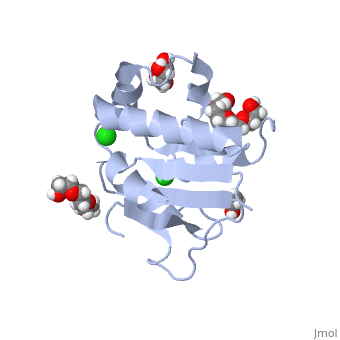5euu
From Proteopedia
Rat prestin STAS domain in complex with chloride
Structural highlights
FunctionS26A5_RAT Motor protein that converts auditory stimuli to length changes in outer hair cells and mediates sound amplification in the mammalian hearing organ. Prestin is a bidirectional voltage-to-force converter, it can operate at microsecond rates. It uses cytoplasmic anions as extrinsic voltage sensors, probably chloride and bicarbonate. After binding to a site with millimolar affinity, these anions are translocated across the membrane in response to changes in the transmembrane voltage. They move towards the extracellular surface following hyperpolarization, and towards the cytoplasmic side in response to depolarization. As a consequence, this translocation triggers conformational changes in the protein that ultimately alter its surface area in the plane of the plasma membrane. The area decreases when the anion is near the cytoplasmic face of the membrane (short state), and increases when the ion has crossed the membrane to the outer surface (long state). So, it acts as an incomplete transporter. It swings anions across the membrane, but does not allow these anions to dissociate and escape to the extracellular space. Salicylate, an inhibitor of outer hair cell motility, acts as competitive antagonist at the prestin anion-binding site (By similarity). Publication Abstract from PubMedPrestin is a unique ATP- and Ca2+-independent molecular motor with piezoelectric characteristic responsible for the electromotile properties of mammalian cochlear outer hair cells, that is the capacity of these cells to modify their length in response to electric stimuli. This "electromotility" is at the basis of the exceptional sensitivity and frequency selectivity distinctive of mammals. Prestin belongs to the SLC26 family of anion transporters and needs anions to function properly, in particular chloride. By X-ray crystallography here we reveal that the STAS domain of mammalian prestin, considered an "incomplete" transporter, harbor an unanticipated anion-binding site. In parallel we present the first crystal structure of a prestin STAS domain from a non-mammalian vertebrate prestin (chicken) that behaves as a "full" transporter. Notably, in chicken STAS the anion-binding site is lacking due to a local structural rearrangement, indicating that the presence of the STAS anion-binding site is exclusive to mammalian prestin. The STAS domain of mammalian SLC26A5 prestin harbors an anion-binding site.,Lolli G, Pasqualetto E, Costanzi E, Bonetto G, Battistutta R Biochem J. 2015 Dec 3. pii: BJ20151089. PMID:26635354[1] From MEDLINE®/PubMed®, a database of the U.S. National Library of Medicine. See AlsoReferences
| ||||||||||||||||||||

